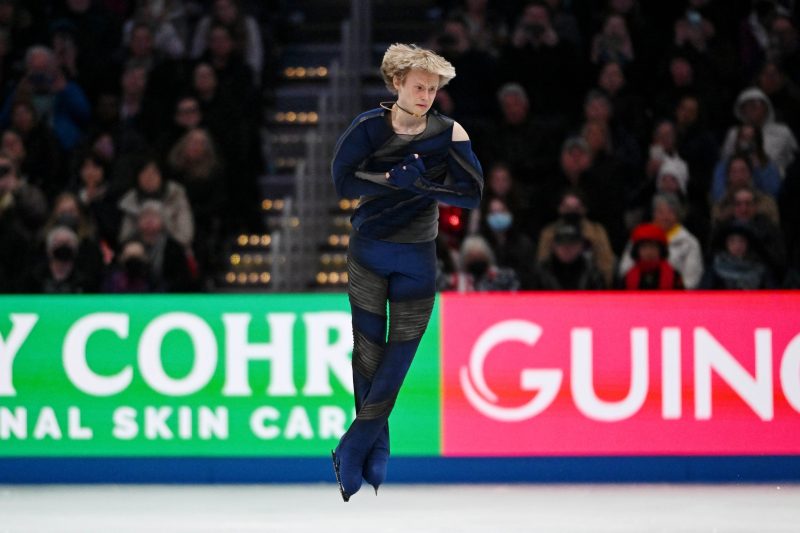
BOSTON — Ilia Malinin could attempt as many as seven quadruple jumps in his long program Saturday, as he seeks to defend his world championship title.
One of them could be the famous jump that only he can pull off: The quad axel.
Malinin, 20, is the only person in figure skating history to successfully land the quad axel in international competition − a milestone for a sport in which jumps have played an increasingly important role. It’s become Malinin’s calling card, part of the moniker that he adopted several years ago, when he changed his Instagram handle to ‘quadg0d.’ And you’re sure to hear a lot more about the quad axel as the 2026 Winter Olympics in Milan-Cortina approach.
So what’s the big deal with the quad axel, exactly? What makes it that much more difficult than any other quadruple jump? Here are the answers to those questions, and everything else you need to know about the jump.
What is a quad axel?
There are six types of jumps in figure skating: Toe loop, flip, lutz, salchow, loop, and axel. The differences between the jumps lie in the method of takeoff and landing.
For instance, the first three jumps on the above list − toe loop, flip and lutz − are toe jumps, in which the skater uses the toe pick on his or her skate to elevate off the ice. The other three (salchow, loop and axel) are edge jumps. Taking off or landing on the inside edge, versus the outside one, is what differentiates the jumps.
The axel is unique because it is the only jump in which a skater takes off facing forward and lands backwards. All of the other jumps have a backwards takeoff. The ‘quad’ part of the quad axel indicates that there are four rotations in the jump.
What makes the quad axel so difficult?
The short answer is that quads, in general, are extremely difficult − even for most Olympic skaters. And the axel is the most difficult of the jumps because of the front-facing takeoff. This means the quad axel actually consists of 4.5 rotations, rather than four. No skater has ever landed a quintuple jump.
But Mexican skater Donovan Carrillo said there’s way more to the mythical nature of the quad axel than that. Physically, he said, it’s an incredible feat.
‘It’s a jump where you start from one foot, then you do four rotations and a half, you land on the other foot. But you only have less than a second to achieve those four and a half rotations,’ Carrillo explained. ‘So physically, it’s so crazy that (Malinin) is doing that jump. Just thinking about it, it’s just so crazy.’
When did Ilia Malinin first land a quad axel?
Malinin first landed the quad axel in competition at the U.S. International Figure Skating Classic in Lake Placid, New York in September 2022. It was the first clean, fully-rotated quad axel to be performed in competition.
‘When I’m practicing it, it’s pretty easy for me to figure out how to get the right timing and everything to have it be a good attempt,’ Malinin said afterwards. ‘To do it in competition is a different story because you have nerves and pressure that can get in the way of that. So I have to treat it like I’m at home, and it feels pretty good.’
What is the point value of a quad axel in figure skating?
The quad axel has a base value of 12.5 points, which is a full point more than the second most difficult jump, the quad lutz. But skaters can also earn points for grade of execution on top of the base value, depending on the crispness and technical elements of the jump. Malinin’s quad axel at nationals, for instance, was actually worth 16.79 points.
Some in the figure skating community have argued that the quad axel is actually undervalued, given that only one person has ever done it. It’s similar to the debate around Simone Biles and her famed Yurchenko double pike vault.
Is the quad axel easy for Ilia Malinin?
There are times he certainly makes it look easy. But in a conference call before nationals earlier this year, he said he and the quad axel ‘have a really big love-hate relationship with each other.’
‘There’s days where it cooperates and I feel really confident about it, and there’s some days where I still need to work on it a little bit and touch it up,’ Malinin said. ‘It’s been pretty normal into my training routine in practices, but sometimes it still is the quad axel. So it really does still [require] that energy and that mental focus that I need to put into it.’
Contact Tom Schad at tschad@usatoday.com or on social media @tomschad.bsky.social.





























